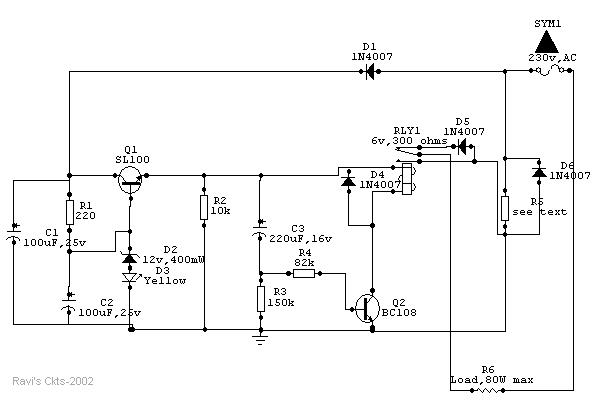Auto Heat Limiter for Soldering Iron

| Wattage of load | 10W | 18W | 25W | 35W | 65W | 80W |
| Value of R5 (in ohms) | 330 | 180 | 136 (68+68) | 100 | 56 | 44 (22+22) |
| Wattage of R5 (in watts) | 01 | 02 | 02 | 04 | 05 | 6.5 |
Usually a soldering iron takes a couple of minutes to get adequately heated up to
melt the solder, after which the heat generated is much above the requirement and
is wasted. Moreover, excessive heat decreases the life of the bit and the element,
causing serious damage to the components.
The above circuit solves this problem in a simple and inexpensive way and could
be used to various types of loads up to 80watts.
How it works
Once the main is switched on, an approximate 15v drop of the positive half cycle
across R5 is detected and supplied to Q1 (SL100 or D313), which acts as a voltage
regulator. Zener diode D2 together with diode D3 (yellow LED) stabilizes the emitter
voltage of Q1 at 13.2Vdc, which is then delivered to the relay circuit built around
Q2 and C3. Capacitor C3 charges through the base-emitter path of Q2 and causes the
relay to actuate, which in turn allows both the half cycles of the AC mains to flow
through diode D6 and R5 to the load to heat it up at a normal rate.
After a certain lapse of time (about 2 minutes preset) C3 saturates and Q2 stops
conducting through the relay, thus switching on series diode D5 to allow only half
of the Ac cycle through the load.
After switching off the system, C3 discharges very slowly through R2 and R3. Before
C3 gets completely discharged, if the power is switched on again, C3 takes a shorter
time to reach the saturation level, thus switching series diode D5 much earlier
than the preset time to prevent double heating of the load.
However, if the circuit is switched on only after a few seconds of switching off,
C3 gets no time to discharge and the relay does not actuate at all. Moreover, if
the relay circuit fails due to any reason and Q2 does not conduct, no harm is done
to the load because in that case D5 remains in series with it. Thus the circuit
offers complete protection to the load.
As stated earlier, the given value of C3 gives a delay of 2 minutes. However, a
1000mfd capacitor can also be used to produce a 4.5-minute delay. R5 maintains a
drop of about 15V across itself. So for use in different load conditions its value
changes as shown in Table 1.
The whole circuit can be mounted on a PCB and fitted in an adapter case (7.6cm X
5.1cm X 6.4cm) and used as a mains plug. Since R5 gets heated up during the operation,
it should be kept well isolated from the other components.
Components List
R1 - 220 ohms
R2 – 10K
R3 – 150K
R4 – 82K
(all resistors should be 5% close tolerance)
C1- 100 uf, 25V dc working electrolytic
C2 – 100 uf, 25V dc working electrolytic
C3 – 220 uf, 16V dc working electrolytic
(advisable to use close tolerance Caps. to obtain correct timings)
D1, D4, D5, & D6 – IN4007
D2 – 12V 400mw, Zener diode
D3 – Yellow LED
RLY1 – 6V, 300 ohms DC relay
Q1 – SL100 or D313
Q2 – BC108
Caution: Certain part of this circuit is directly connected to AC mains. Therefore,
do not touch whilst in operation.
| Please take the greatest of care in handling AC mains supply while constructing this project. If you have no knowledge of mains wiring or unfamiliar with household mains supply, PLEASE DO NOT ATTEMPT CONSTRUCTION. I take no responsibility in any personal injury or loss of life or properties suffered by any person while undertaking the construction of this project or using the end product by following my instructions. |
![]() Download this project in doc format
Download this project in doc format
Title: Auto Heat Limiter for Soldering Iron
electronic circuit
Source: www.electronics-lab.com
Published on: 2005-02-03
Reads: 980
Print version: ![]()
Other electronic circuits and schematics from Motor, light and power control
-
LASER Transmitter/Receiver
-
18 Stage LED Sequencer
-
220 Volts Flashing Lamps
-
Dark-activated LED or Lamp Flasher
-
Digital Stopwatch 0-60sec
-
Optical toggle switch using a single Chip
-
Knightrider lights for model cars
-
120VAC Lamp Chaser
-
25 Light Sequencer using Xmas lamps
-
Automatic 12 Volt Lamp Fader
